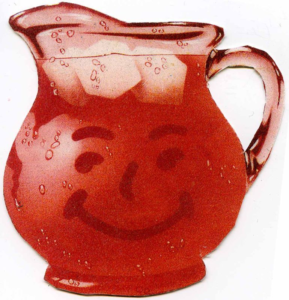I grew up enjoying Kool-Aid during the heat of the summer … it was a refreshing, cheap, and just plain fun to make. My entrepreneurial streak saw the opportunity to sell glasses of it to passerby pedestrians. I think we all have an image of that glass jug with moisture on the outside and a smiley face as shown here. What fun .. and for those who are trying to cut calories, you can even get it sugar free. What is so wrong with all this?
the opportunity to sell glasses of it to passerby pedestrians. I think we all have an image of that glass jug with moisture on the outside and a smiley face as shown here. What fun .. and for those who are trying to cut calories, you can even get it sugar free. What is so wrong with all this?
Well, let’s start with those artificial sweeteners. Do you remember the original one: saccharin? It was banned due to fears that it caused cancer which was later discredited, but more importantly it is known to have no nutrient value … it may not be bad for you, but it is certainly not good for you. Drink water, and please avoid bottled water. If you want, use a filter but be aware that many of them will take the beneficial fluoride out of it. Let’s come back to that after we take a deeper dive on what Kool Aid now means.
As Wikipedia indicates, “Drinking the Kool-Aid” is an expression used to refer to a person who believes in a possibly doomed or dangerous idea because of perceived potential high rewards. The phrase typically carries a negative connotation. It can also be used ironically or humorously to refer to accepting an idea or changing a preference due to popularity, peer pressure, or persuasion. In recent years, it has evolved further to mean extreme dedication to a cause or purpose, so extreme that one would “drink the Kool-Aid” and die for the cause.
While use of the phrase dates back to 1968 with the nonfiction book The Electric Kool-Aid Acid Test, it is strongly associated with the events in Jonestown, Guyana, on November 18, 1978, in which over 900 members of the Peoples Temple movement died. The movement’s leader, Jim Jones, called a mass meeting at the Jonestown pavilion after the murder of U.S. Congressman Leo Ryan and others in nearby Port Kaituma. Jones proposed “revolutionary suicide” by way of ingesting a powdered drink mix made from Flavor Aid (later misidentified as Kool-Aid) that was lethally laced with cyanide and other drugs.
We are witnessing an age of artificial sweeteners on EVs … which are not helpful in a sustainable business model. Don’t we remember when then President Obama sweetened the opportunities for smart grid implementations. Sure, it resulted in a “pull forward” demand for these ideas but that simply resulted in a boom bust cycle. Everyone was drunk with enthusiasm when those incentives appeared, but no one (except me) pointed out that there was going to be a disaster in the years that followed. They had bought forward the customers who were on the fence about smart grid investments … and how could they turn down the sweeteners?
We need to cool our jets on ideas like “banning the internal combustion engine” and start teaching people how to think differently about the driving experience. We should not be sweetening the perspective of jackrabbit performance and long range. Where are the thoughts we learned helped like reducing speed limits which we did during the energy crises of the late 1970s.
It might be a bit harsh to compare the EV hype with Jonestown, but the parallels are clear.
We are going to kill off most of the emerging EV companies with artificial sweeteners.
